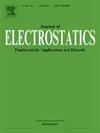常压下多个SDBD装置的耦合空间灭菌研究
IF 2.1
4区 工程技术
Q3 ENGINEERING, ELECTRICAL & ELECTRONIC
引用次数: 0
摘要
本研究设计了多种表面介质阻挡放电(SDBD)耦合灭菌装置,以满足牙科实践中微生物气溶胶的灭菌要求。建立了模拟空气电离过程的多电极结构模型,阐明了电离过程中活性物质的空间分布和外加电场。形成的正离子以O4+为主,负离子以O2−为主,数量密度达到1018 m−3。静电模拟结果表明,该装置内的电位和电场分布均匀,为优化多发电机的布置提供了重要的见解。建立了集成多个SDBD装置的实验平台,对金黄色葡萄球菌和大肠杆菌进行了灭菌实验,并比较了单层和双层配置的灭菌性能。单层灭菌装置在30 min内灭菌率可达99.9%,双层发生器灭菌装置在20 min内灭菌率可达99.99%以上。本文章由计算机程序翻译,如有差异,请以英文原文为准。
Coupled space sterilization study of multiple SDBD devices under atmospheric pressure
In this study, multiple surface dielectric barrier discharge (SDBD) coupled sterilization devices were designed to meet the sterilization requirements of microbial aerosols in dental practices. A multi-electrode structure model was established to simulate the air ionization process, elucidating the spatial distribution of active species and the external electric field during ionization. The predominant positive and negative ions formed were O4+ and O2−, respectively, with number densities reaching up to 1018 m−3. Electrostatic simulation results indicated a uniform distribution of potential and electric fields within the device, offering critical insights for optimizing the arrangement of multiple generators. An experimental platform integrating multiple SDBD devices was also established to conduct sterilization experiments on Staphylococcus aureus and Escherichia coli, while comparing the sterilization performance of single-layer and double-layer configurations. The single-layer sterilization device could achieve 99.9 % sterilization rate in 30 min, and the double-layer generator sterilization device could achieve more than 99.99 % in 20 min.
求助全文
通过发布文献求助,成功后即可免费获取论文全文。
去求助
来源期刊

Journal of Electrostatics
工程技术-工程:电子与电气
CiteScore
4.00
自引率
11.10%
发文量
81
审稿时长
49 days
期刊介绍:
The Journal of Electrostatics is the leading forum for publishing research findings that advance knowledge in the field of electrostatics. We invite submissions in the following areas:
Electrostatic charge separation processes.
Electrostatic manipulation of particles, droplets, and biological cells.
Electrostatically driven or controlled fluid flow.
Electrostatics in the gas phase.
 求助内容:
求助内容: 应助结果提醒方式:
应助结果提醒方式:


